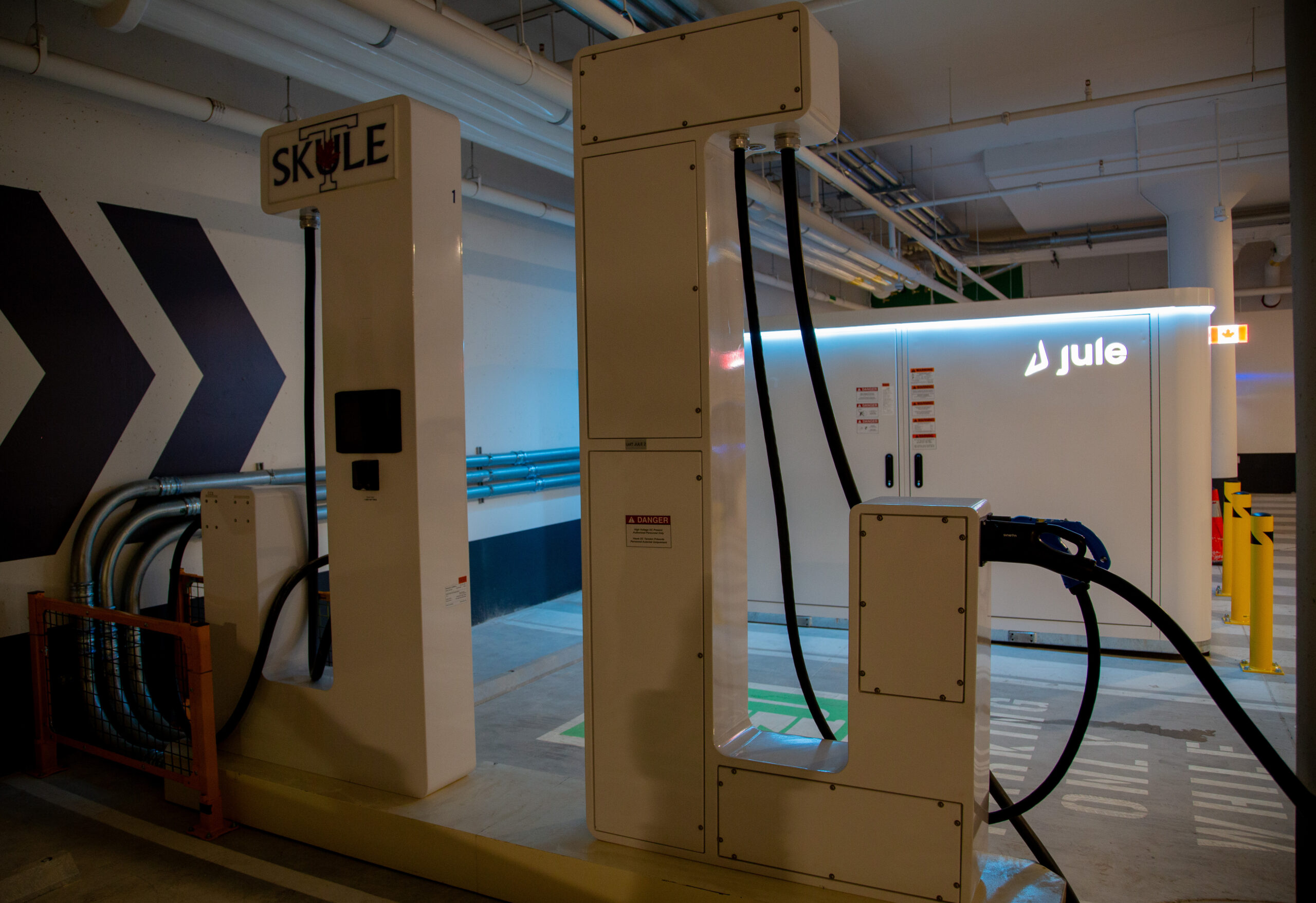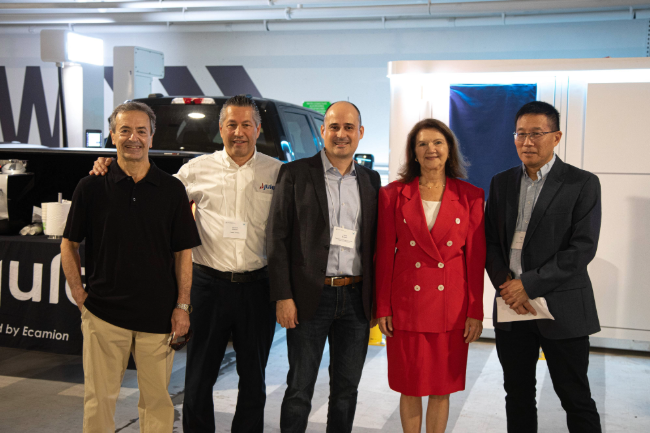Through a partnership with Jule powered by eCAMION, U of T Engineering researchers are meeting the demand for innovative energy solutions that can help advance the widespread adoption of electric vehicles (EV).
U of T research has contributed to the development of the world’s first direct current (DC) sourced electric vehicle fast charger with an integrated battery energy storage system. Now, two of these Level 3+ fast-charging stations from the Canadian energy storage and EV solutions provider will be available in U of T’s Landmark Garage, located underneath King’s College Circle at the St. George Campus.
This innovation offers drivers the ability to charge their EVs in under 30 minutes while minimizing the strain on the electrical grid.
Jule was co-founded by U of T Engineering alumnus Carmine Pizzurro (MIE 8T9, MIE MEng 9T3) in 2009, and today the company employs 14 U of T alumni.
In 2010, Jule embarked on its first research collaboration with U of T, working with Professor Reza Iravani (ECE) and his lab group at the Centre for Applied Power Electronics.
“Professor Iravani played a crucial role in the early development and direction of the technology through his technical expertise, guidance and collaborative mindset,” says Pizzurro.
“One of our first collaborations was with Toronto Hydro, which led to us being the first company in the world to put lithium-ion batteries on the distribution grid to provide backup power during outages and reduce stress on the grid during peak periods.”
Pizzurro went on to work with Natural Resources Canada (NRCan) to install Jule’s very first battery-powered fast chargers in Northern Canada, in areas with limited grid infrastructure.
But lithium-ion batteries are temperature-sensitive, and powering a net-zero future requires battery systems that can operate reliably and efficiently in both hot and cold environments.
To achieve this goal, it is necessary to advance battery thermal management systems, which control a system’s operating temperature by providing effective cooling or heating.
In response to this challenge, Jule’s partnership with U of T Engineering expanded in 2018 to include Professor Cristina Amon (MIE) and Carlos Da Silva.
Amon and Da Silva are leading researchers at the Advanced Thermofluids Optimization, Modelling and Simulation (ATOMS) laboratory, advancing Jule’s technology on thermal management of batteries and power electronics.
They are doing this by developing computational models and experimental characterization in their new CFI-ORF-funded battery testing facility to optimize the battery-powered charging system’s performance through better thermal control.

“Thermal management is an issue that impacts both aspects of Jule’s EV fast charging technology: the power electronics to enable the charging, as well as their unique integrated battery storage system,” says Da Silva, executive director of the Electrification Hub.
“Thermal management is critical for mitigating battery degradation. It requires regulating the temperature in such a way that you keep the battery within an optimal range that will extend its life span.”
By using energy stored in batteries, rather than drawing it directly from the electrical grid, the way traditional fast chargers work, Jule’s fast chargers don’t cause grid overloading during peak usage times or require significant investments in electricity upgrades.
In fact, battery energy storage systems can be charged during off-peak hours when electricity is less costly.
“The battery storage system is charged using current from the electrical grid, which is alternating current (AC); and then this larger battery, which uses direct current, charges the smaller battery in the electric vehicle,” says Amon.
“It is more efficient to fast charge from a stationary battery to an EV, DC to DC, than it is to fast charge an EV from the electrical grid, which requires converting AC to DC power.”
Jule’s Level 3+ charging station can provide up to 200 kW power output, yet only needs 45 kW of input power. This rapid charging speed can offer many benefits for drivers, including helping to alleviate range anxiety.
“Some drivers fear that EV batteries may not have enough energy to reach a desired destination,” says Amon.
“But if charging time is much closer to the time required to fill up a tank of a gas-powered car, that can reduce this worry.”
The new electric vehicle fast charging stations are joining 48 level 2 chargers that are available for public use at the Landmark Garage. This increases the campus’s charging capacity to over 25,000 charges per year, which can eliminate over 700 tons greenhouse gas emissions, according to U of T’s Sustainability Office.
“Hosting these first-of-their-kind EV chargers right here on campus extends beyond providing a new and exciting sustainability service to our community,” says Ron Saporta, chief operating officer, property services & sustainability at U of T.
“It represents just one example of how we are supporting the intersection of research, learning and commercialization of sustainable innovations developed by members of our very own U of T community.”
These fast-charging stations will also serve as a living lab to test future thermal innovations jointly developed by U of T Engineering researchers and Jule.
“Having these chargers on campus enables us to have a greater capacity to test the system in ways we are limited by doing in a lab setting,” says Da Silva.
“The technology that we are developing in battery thermal management will have many positive implications, especially to advance technologies such as bidirectional charging and V2X — vehicle to everything — which can facilitate a vehicle’s energy to go two ways, from direct current energy to alternating current energy that can power vehicle to vehicle, or vehicle to building or vehicle to infrastructure.”





